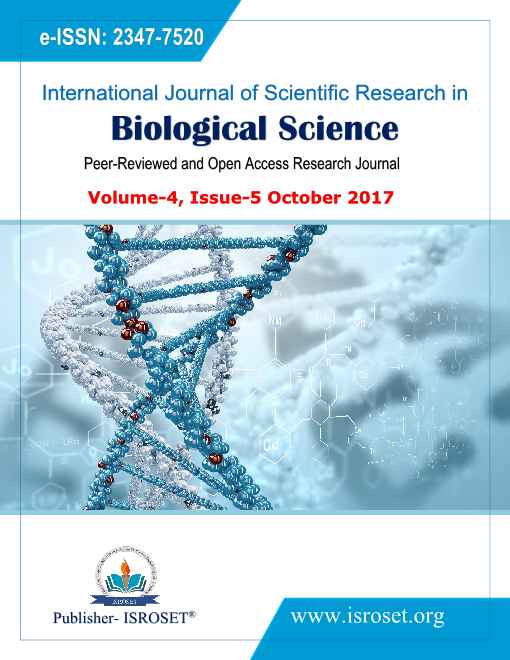Egg parasitism caused by Trichogramma spp. against maize stem borer, Chilo partellus.
Keywords:
Trichogramma spp, discovery efficiency, egg parasitism, parasitism efficiencyAbstract
Present study was carried out to determine the numbers of egg batches and eggs per batch in the maize fields of selected sites of Indore. Moreover, discovery efficiency and parasitism efficiency was also determined. The result revealed that highest mean discovery efficiency rates of Trichogramma spp. was found from Mhow and was therefore having low parasitism per field and lowest mean discovery efficiency rate was recorded from Mangliya and was having high parasitism per field. There was generally a high variation in the numbers of egg batches and eggs per batch among the sites surveyed. The predominant parasitoid species was Trichogramma spp. This study showed that although egg parasitoid species diversity was higher, egg parasitism was considerably lower in selected sites of Indore.
References
F. Bigler, “Mass production of T. maidis Pint, et voeg and its field application against Ostrinia nubilalis Hbn”,. In ndl. J App Entomol, vol.101, No.1-5, pp. 23-29, 1986.
F. Ullah, M. Shakur, H. Badshah, S. Ahmad, M. Amin, M. Zamin, “Efficacy of T. chilonis Ishii in comparison with two commonly used insecticides against sugarcane stem borer C. infuscatellus Snelless (Lepidoptera: Pyralidae)”, J Anim Plant Sci, Vol. , No.4 , pp.463-466, 2012.
Z.Y. Wan, K. He, J.Z. Zhao, D.R. Zhao, “ implementation of integrated pest management in china”, In “ Integrated pest management in the global arena” (K.M. Maredia, D. bakous and D. Mote- Sanchez. EDS),pp. 197-207. CABI Publishing, Oxon, 2003.
S.A. Hassan, “Mass production and utilization of T. production of host Sitotroga cerealella”, Entomophaga, Vol.26, No.4, pp. 339-347, 1981.
D. Hussain, H. Ali, M. Qasim, J. Khan, “Insecticidal susceptibility and effectiveness of T. chilonis as a parasitoids of tomato fruit borer, Helicoverpa armigera”, Pak J Zoo, Vol. 47, No. 5, pp.1427-1432, 2015.
P. Abhilash, K. Rajmohana, “A new species of Gryon Haliday (Hymenoptera: Platygastridae) from India”, Journal of Threatened Taxa, vol. 6, No.14, pp. 6711–6714, 2014.
F. Schulthess, O.A. Chabi, G. Geogen, “Seasonal fluctuation of Noctuid stem borer egg parasitism in southern benin with reference to Sesamia calamistis (Lepidoptera: Noctuidae) and Telonomus spp. (Hymenoptera : Schonidae) on maize”, biocontrol science and technology, Vol.11, No. 1,pp. 745-757, 2001
R. Ndemah, F. Schulthes, S. Kories, C. Borgemeister, K.F. Cardwell, “Distribution, relative importance and effect of lepidopterous borers on maize fields in the forest zone and mid altitude of cameroon”. Journal of economic entomology. Vol.94, No.9-10, pp.1434-1444, 2001
O. Chabi, A. Nolte, F. Schulthess, M.C. Borge, “Effects of grain legumes and cover crops on maize yield and plant damage by Busseola fusca (fuller) (Lepidoptera : Noctuidae) in the humid forest of southern cameron. Agriculture”, Ecosystem and environment, Vol.108, No. 7, pp. 17-28, 2005.
P. Chindwada, W.A. Overholt, “ Natural enemies of MSB on the high veld of zimbabwe”, African Entomology, Vol.9, No. 5, Pp. 67-75, 2001.
F. Bin, S. Vinson, “Efficacy assessment in egg parasitoids (Hymenoptera): proposal for a unified terminology. Trichogramma and other egg parasitoids San Antonio (TX), 23–27 September, 1990. Les Colloques no. 56. INRA, Paris, 1991.
H. Vijayakumar, S. K. Jalali, Prakash “Suitable Trichogramma sp. and dosage for the management of Chilo partellus (Swinhoe) in maize”, Journal of Experimental Zoology, Vol. 18, No. 1, pp 253-256, 2015.
S. Y. Li, D. E. Henderson, J. H. Meyer, “Selection of suitable Trichogramma species for potential control of the blackheaded fire worm infesting cranberries”. Biocontrol, Vol.4, No.3, pp 244-248, 1994.
Downloads
Published
How to Cite
Issue
Section
License

This work is licensed under a Creative Commons Attribution 4.0 International License.
Authors contributing to this journal agree to publish their articles under the Creative Commons Attribution 4.0 International License, allowing third parties to share their work (copy, distribute, transmit) and to adapt it, under the condition that the authors are given credit and that in the event of reuse or distribution, the terms of this license are made clear.







